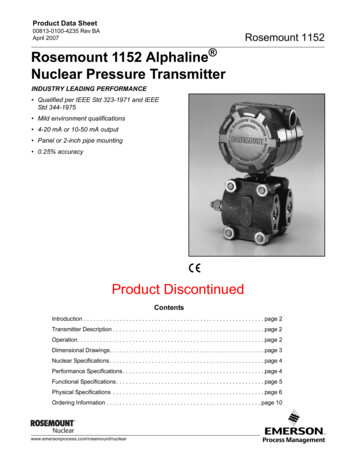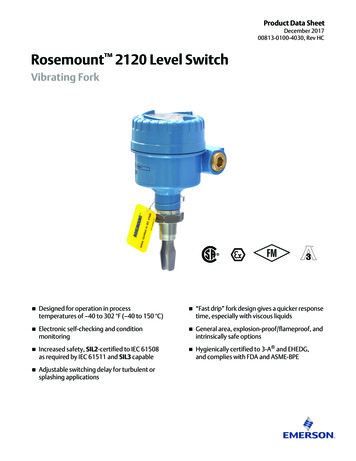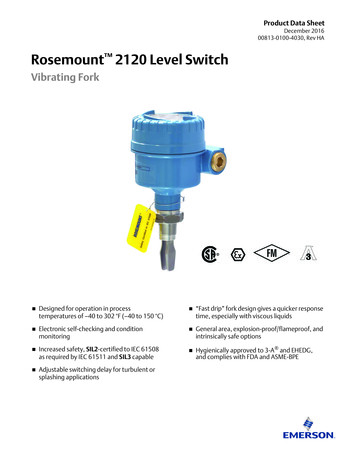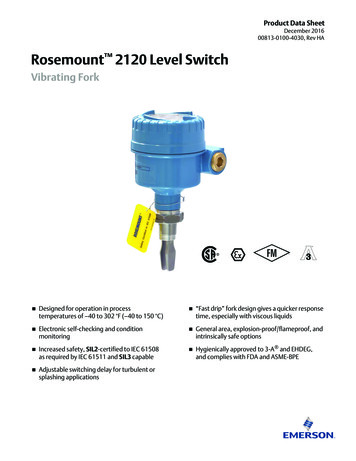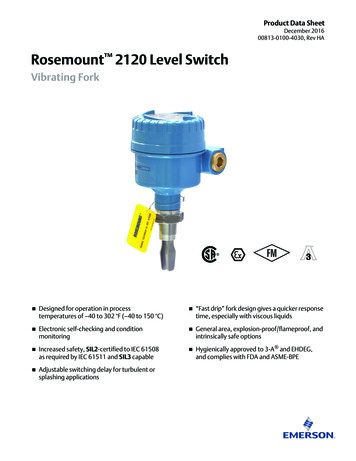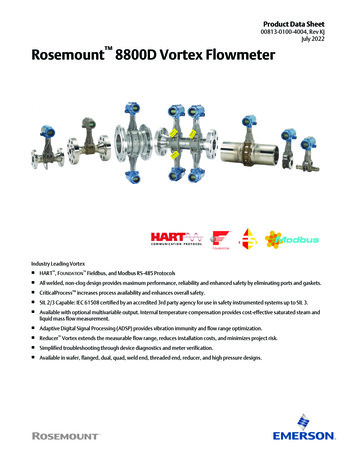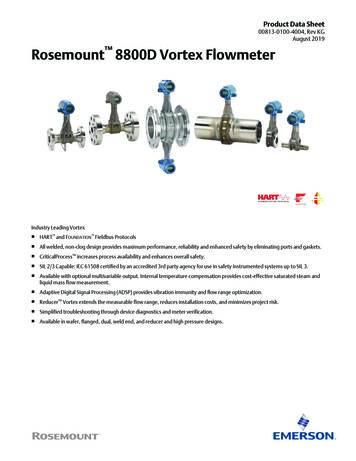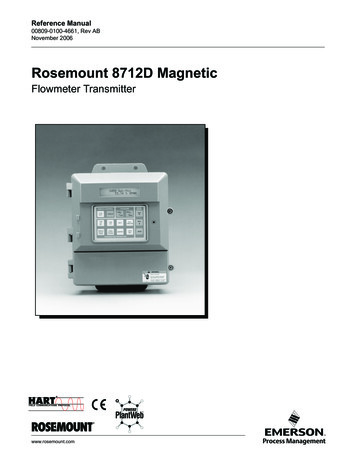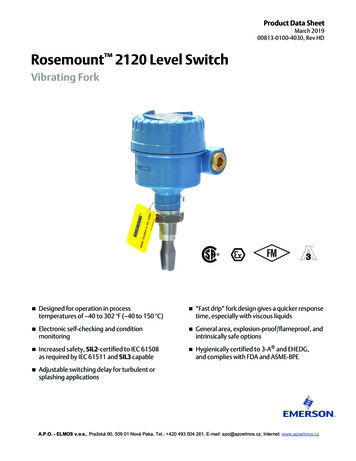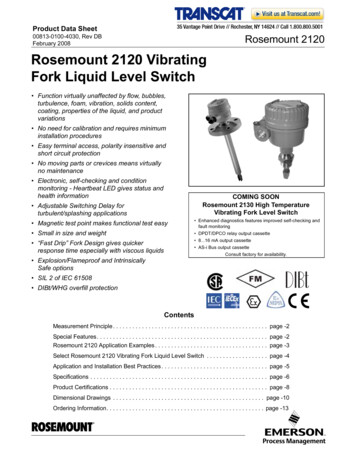
Transcription
Quick Installation Guide00825-0100-4716, Rev DAOctober 2009Rosemount 3095 MultiVariableRosemount 3095 MultiVariable Mass FlowTransmitter with HART or FOUNDATION Fieldbus ProtocolRosemount 3095MF Series Flowmeter TransmitterProductDiscontinuedStartStep 1: Mount the TransmitterStep 2: Transmitter InstallationStep 3: Software InstallationStep 4: Connect the Wiring and Power Up (HART or Fieldbus)Step 5: Configure the Transmitter (HART or Fieldbus)Step 6: Trim the TransmitterProduct CertificationsEndwww.rosemount.com 00825-0100-4716/
Quick Installation Guide00825-0100-4716, Rev DAOctober 2009Rosemount 3095 MultiVariable 2009 Rosemount Inc. All rights reserved. All marks property of owner. Rosemount and the Rosemount logotype areregistered trademarks of Rosemount Inc.Rosemount Inc.Emerson Process Management GmbH & Co. OHG8200 Market BoulevardChanhassen, MN USA 55317T (US) (800) 999-9307, F (952) 949-7001T (International) (952) 906-8888Argelsrieder Feld 382234 WesslingGermanyT 49 (8153) 9390, F49 (8153) 939172Emerson Process Management Asia PacificPrivate LimitedBeijing Rosemount Far East Instrument Co.,Limited1 Pandan CrescentSingapore 128461T (65) 6777 8211, F (65) 6777 0947No. 6 North Street,Hepingli, Dong Cheng DistrictBeijing 100013, ChinaT (86) (10) 6428 2233, F (86) (10) 6422 8586IMPORTANT NOTICEThis installation guide provides basic guidelines for the Rosemount 3095 MultiVariableMass Flow Transmitter (reference manual document number 00809-0100-4716). It alsoprovides the basic electronics guidelines for the 3095MFA (reference manual documentnumber 00809-0100-4809), the 3095MFC (reference manual document number00809-0100-4810) and the 3095MFP (reference manual document number00809-0100-4686). It does not provide instructions for configuration, diagnostics,maintenance, service, or troubleshooting. Refer to the appropriate reference manual formore instruction. These manuals are also available electronically onwww.rosemount.com.WARNINGExplosions could result in death or serious injury:Installation of this transmitter in an explosive environment must be in accordance with theappropriate local, national, and international standards, codes, and practices. Before connecting a HART-based communicator in an explosive atmosphere, makesure the instruments in the loop are installed in accordance with intrinsically safe ornon-incendive field wiring practices. In an Explosion-Proof/Flame-Proof installation, do not remove the transmitter coverswhen power is applied to the unit. Do not remove the transmitter covers in explosive environments when circuit is live. Both transmitter covers must be fully engaged to meet explosion-proof requirements.Process leaks may cause harm or result in death. To avoid process leaks, only use the o-ring designed to seal with the correspondingflange adapter.Electrical shock can result in death or serious injury. Avoid contact with the leads and the terminals. High voltage that may be present onleads can cause electrical shock.2
Quick Installation Guide00825-0100-4716, Rev DAOctober 2009Rosemount 3095 MultiVariableTRANSMITTER EXPLODED VIEWCertification LabelHousingTerminal Block(HART)O-ringElectronics BoardCoverNameplateModule O-ringSensor ModuleHousing Locking ScrewRTD ConnectorProcess Adapter O-ringDrain/Vent ValveCoplanar FlangeFlange Adapter O-ringOptional Flange AdaptersLCD Display AssemblyBoltsLCD DisplayCoverTerminal Block (Fieldbus)3
Quick Installation Guide00825-0100-4716, Rev DAOctober 2009Rosemount 3095 MultiVariableSTEP 1: MOUNT THE TRANSMITTERLiquid Flow Applications1. Place taps to the side of the line.2. Mount beside or below the taps.3. Mount the transmitter so that the drain/ventvalves are oriented upward.FlowGas Flow Applications1. Place taps in the top or side of the line.2. Mount beside or above the taps.FlowFlowSteam Flow Applications1. Place taps to the side of the line.2. Mount beside or below the taps.3. Fill impulse lines with water.FlowFigure 1. Using a Mounting BracketPanel Mount(1)(1)4Panel bolts are customer supplied.Pipe Mount
Quick Installation Guide00825-0100-4716, Rev DAOctober 2009Rosemount 3095 MultiVariableSTEP 2: TRANSMITTER INSTALLATIONConsider Housing RotationTo improve field access or to better view the optional LCD display:1. Loosen the housing rotation set screw.2. Rotate the housing clockwise to the desired position – up to 180 from its originalposition. Over rotating will damage the transmitter.3. If the desired position is attained, tighten the housing rotation set screw.4. If the desired position cannot be reached because the housing will not rotate further,rotate the housing counterclockwise until in the desired position is attained (up to 180 from its original position).5. Tighten the housing rotation set screw.Housing Rotation SetScrew (9/64-inch)Field Installation1. Mount the transmittera.Install the flange or flange/adapter bolt finger-tight.b.Torque bolts to initial torque value using a cross pattern (see Table 1). Wheninstalling to a mounting bracket, torque bolts to 125 in./lb (169 N/m)Table 1. Torque Cross PatternBolt MaterialInitial ValueFinal ValueCarbon Steel (CS)Stainless Steel (SST)300 in./lb (34 N/m)150 in./lb (17 N/m)650 in./lb (73 N/m)300 in./lb (34 N/m)2. Set the Security Jumper, which is located on the front of the electronics board inside theelectronics housing cover. Putting the Security Jumper in the ON position will protectagainst configuration change from being unintentionally made. The transmitter operatesnormally if the jumpers are not installed. The Security default is OFF.5
Quick Installation GuideRosemount 3095 MultiVariable00825-0100-4716, Rev DAOctober 2009STEP 2 CONTINUED.3. Set the Failure Mode Alarm (HART devices), which is located on the front of theelectronics board inside the electronics housing cover. The Alarm Jumper positiondetermines if the output is driven high or low when a failure is detected. The transmitteroperates normally if the jumpers are not installed and the Alarm default fail is HI.Figure 2. Alarm Jumper LocationSecurity JumperSimulate JumperHART Electronics BoardFOUNDATION fieldbus Electronics Board4. Set the Simulate Jumper (FOUNDATION fieldbus devices), which is located on the front ofthe electronics board inside the electronics housing cover. The jumper is used tosimulate the measurement and is used as a lock-out feature for the AI function block. Toenable the simulate feature, insert the jumper across ENABLE while the transmitter ispowered. The default position for the Simulate Jumper is DISABLE. Enable the simulatefeature after power is applied to the device. Simulate is automatically disabledregardless of jumper position if power is cycled.5. Connect the transmitter to the process.6. Install the RTD Cable Assembly (optional). All RTD 3095 Cable Assemblies use the3095 RTD Cable Connector. Identify the cable type being installed and follow the stepsbelow. Installing an Armored Shielded RTD Cable (See Figure 3)a.Fully engage the black cable connector to the 3095 RTD connector.b.Tighten the cable adapter until metal contacts metal.c. Install the compression fitting.d.Tighten the cap onto the compression fitting.Figure 3. Armored Shielded RTD CableCompression FittingConductive BushingRTD CapCapConnectto RTD3/4 to 1/2-14 NPT Adapter6WasherBlack Cable ConnectorCable AdapterBushingCompression Fitting
Quick Installation Guide00825-0100-4716, Rev DAOctober 2009Rosemount 3095 MultiVariableSTEP 2 CONTINUED. Installing a Shielded 3095 RTD Cable (See Figure 4)Note: Shielded cable is intended for use in a conduit.a.Fully engage the black cable connector to the 3095 RTD Connector.b.Tighten the cable adapter until metal contacts metal.Figure 4. Shielded RTD CableCable Adapter 1/2–14 NPTBlack Cable Connector Installing a ATEX/IECEx Flameproof 3095 RTD Cable (See Figure 5)a.Fully engage the black cable connector to the 3095 RTD Connector.b.Tighten the cable adapter and cable gland until metal contacts metal.Figure 5. ATEX/IECEx Flameproof RTD CableRTD Cable Gland CM20Cable AdapterCable GlandBlack Cable Connector/ RTD Connector7. Check all process connections for leaks.8. Connect the appropriate wiring (see Step 5). Ground the transmitter according tonational and local electrical codes. Install field wiring grounding (optional).7
Quick Installation Guide00825-0100-4716, Rev DAOctober 2009Rosemount 3095 MultiVariableSTEP 2 CONTINUED.Bolting ConsiderationsIf the transmitter installation requires assembly of the process flanges, manifolds, or flangeadapters, follow these assembly guidelines to ensure a tight seal for optimal performancecharacteristics of the transmitters. Use only bolts supplied with the transmitter or sold byEmerson as spare parts. Figure 6 illustrates common transmitter assemblies with the boltlength required for proper transmitter assembly.Figure 6. Common Transmitter AssembliesA. Transmitter withCoplanar FlangeC. Transmitter with TraditionalFlange and Optional FlangeAdaptersD. Transmitter withCoplanar Flange andOptional Manifold andFlange Adapters4 x 2.25-in. (57 mm)4 x 1.75-in. (44 mm)B. Transmitter with CoplanarFlange and OptionalFlange Adapters4 x 1.75-in. (44 mm)4 x 1.50-in. (38 mm)4 x 1.75-in. (44 mm)4 x 2.88-in. (73 mm)Bolts are typically carbon steel or stainless steel. Confirm the material by viewing themarkings on the head of the bolt and referencing Figure 7. If bolt material is not shown inFigure 7, contact the local Emerson Process Management representative for moreinformation.Use the following bolt installation procedure:1. Carbon steel bolts do not require lubrication and the stainless steel bolts are coated witha lubricant to ease installation. However, no additional lubricant should be applied wheninstalling either type of bolt.2. Finger-tighten the bolts.3. Torque the bolts to the initial torque value using a crossing pattern. See Figure 7 for initialtorque value.4. Torque the bolts to the final torque value using the same crossing pattern. See Figure 7for final torque value.5. Verify that the flange bolts are protruding through the isolator plate before applyingpressure.8
Quick Installation Guide00825-0100-4716, Rev DAOctober 2009Rosemount 3095 MultiVariableSTEP 2 CONTINUED.Figure 7. Torque values for the flange and flange adapter boltsBolt MaterialHead MarkingsInitial Torque Final TorqueCarbon Steel (CS)300 in.-lbs.650 in.-lbs.150 in.-lbs.300 in.-lbs.B7MStainless Steel (SST)316B8M316RSTM316316SW316O-rings with Flange AdaptersWARNINGFailure to install proper flange adapter O-rings may cause process leaks, which can result in death orserious injury. The two flange adapters are distinguished by unique O-ring grooves. Only use the O-ringthat is designed for its specific flange adapter, as shown below.Rosemount 3051S / 3051 / 2051 / 3095Flange AdapterO-ringPTFE BasedElastomerRosemount 1151Flange AdapterO-ringPTFEElastomerWhenever the flanges or adapters are removed, visually inspect the o-rings. Replace them ifthere are any signs of damage, such as nicks or cuts. If the o-rings are replaced, re-torquethe flange bolts and alignment screws after installation to compensate for seating of thePTFE o-ring.9
Quick Installation GuideRosemount 3095 MultiVariable00825-0100-4716, Rev DAOctober 2009STEP 3: SOFTWARE INSTALLATIONThe 3095 Engineering Assistant (EA) for HART and 3095 Engineering Assistant (EA) forFOUNDATION Fieldbus software programs can be installed on the same computer. Theapplications cannot be open simultaneously.3095 Engineering Assistant (EA) for HART Software Installation1. Install the Programa.Place the CD-ROM in the drive and run setup.exe from Windows NT, 2000, or XP.b.After installing the software, install the HART Modem (see “Installing the HARTModem” on page 11).2. Upgrade the previous versions of Engineering Assistant program (if required)a.Place the CD-ROM disk 2 into the drive and run the EAUpgrade.exe from Windows98, NT, 2000, or XP. To properly install, the program will first uninstall EngineeringAssistant from the computer. (Upgrades also are available at www.rosemount.com.)b.Remove the installation disk and reboot the computer to complete installation.c. To install the upgraded program, run the EAupgrade.exe from Windows 95,98, orNT again.3. Connect the computer to the 3095 transmitter.a.Connect the HART modem cable to the computer using the 9-pin serial or USBcommunications port on the computer.b.Open the cover above the side marked Field Terminals, and connect themini-grabbers to the two 3095 terminals marked COMM.4. Select Engineering Assistant for HART from the program menu.On-Line Mode: EA communicates directly with the 3095 through AMS.a.In AMS Explorer view or AMS Connection view, right-mouse click on a 3095 devicetag or icon.b.Select SNAP-ON/Linked Apps Engineering Assistant.Off-Line Mode: Engineering Assistant does not communicate directly with the 3095.Instead, the EA configuration is sent to a 3095 later when Engineering Assistant is inon-line mode. In the off-line mode a future device needs to be created in order to launchEngineering Assistant.a.In AMS Explorer view or AMS Device Connection view, left click on Plant Databaseto the Area folder.b.Left click on Area to the Unit folder.c. Left click on Unit to the Equipment Module folder.d.Left click on Equipment Module to the Control Module folder.e.right-mouse click on Control Module to the pop-up context menu.f. Select Add Future Device.g.Select 3095MV Template and click OK.h.Right-mouse click on Future device to pop-up context menu.i. Select SNAP-ON/Linked Apps Engineering Assistant.10
Quick Installation Guide00825-0100-4716, Rev DAOctober 2009Rosemount 3095 MultiVariableSTEP 3 CONTINUED.Installing the HART ModemAfter installing the 3095 Engineering Assistant, the HART modem configuration windowautomatically appears when the 3095 Engineering Assistant is opened. If this window iscanceled, the HART modem may be installed manually with the following procedure.1. Close AMS. From the Start Menu select Programs 3095 Engineering Assistant AMS Network.2. Select Add from the AMS Network Configuration window. A “Select AMS NetworkComponent Type” window will open.3. Select Hart Modem.4. Select Install.5. Step through the Wizard. A prompt will inquire a COMM PORT. A typical default is“COMM 1”.6. Select OK. Close out of the AMS Network Configuration window.7. Re-open the HART Modem Properties. Click on the Connection tab and set the RetryCount to 5. Click the Advanced tab and check the Multidrop checkbox and set theAddress Range as 0 to 2.8. The configuration change will activate when 3095 Engineering Assistant is launched.NOTEExit from the program if a Palm Pilot HotSync or any other program is shared with theCOMM PORT.3095 Engineering Assistant (EA) for FOUNDATION Fieldbus1. Install the 3095 Engineering Assistant for FOUNDATION Fieldbus Program andthe FOUNDATION fieldbus communication card drivers.a.Place CD-ROM disk 2 into the drive.b.Browse and select 3095 Engineering Assistant for FOUNDATION Fieldbus softwareapplication from Windows NT, 2000, or XPc. Open the ReadMe.txt file and follow the instructions provided.2. Install the FOUNDATION Fieldbus communication card.a.Insert either the PCMCIA card or PCI card into the computer, following theinstructions provided with the communications card.3. Connect the 3095 transmitter to computer and establish communications.a.Connect the 9-pin communications cable into the FOUNDATION Fieldbus card portlocated in the computer.b.Connect communication wiring to connection ports labeled “D ” and “D-”.c. Open the transmitter cover on the side marked “Field Terminals” and connect thecommunication wires to the two 3095 transmitter terminals labeled “FieldbusWiring”.4. Select the 3095 Engineering Assistant for FOUNDATION Fieldbus from the program menuor use the 3095 EA FOUNDATION fieldbus shortcut icon.11
Quick Installation Guide00825-0100-4716, Rev DAOctober 2009Rosemount 3095 MultiVariableSTEP 4: CONNECT WIRING AND POWER UP (HART)Use the following steps to wire the transmitter:1. Remove the housing cover on the side marked FIELD TERMINALS.2. Connect the signal leads to the terminals.NOTEDo not connect the powered signal wiring to the test terminals. Power could damage the testdiode in the test connection. Shielded twisted pair cable should be used for best results. Use24 AWG or larger wire and do not exceed 5,000 feet (1500 meters).3. Plug and seal unused conduit connections.4. Install wiring with a drip loop. Arrange the drip loop so the bottom is lower than theconduit connections and the transmitter housing.5. Replace the housing cover.Figure 8 shows wiring connections necessary to power a 3095 and enable communicationswith a hand-held HART communicator.Figure 8. Transmitter Wiring Diagrams (4–20 man Power Supply)24 Vdc SupplyCurrentMeterRL 250 Installation of the transient protection terminal block does not providetransient protection unless the 3095 case is properly grounded.The dc power supply should provide power with less than two percent ripple. The totalresistance load is the sum of the resistance of the signal leads and the load resistance of thecontroller, indicator, and related pieces. Note that the resistance of intrinsic safety barriers, ifused, must be included.Figure 9. Load LimitationLoad (Ohms)Max. Loop Resistance Power Supply )16.5(2)Power Supply55(1) For CSA approval, power supply must not exceed 42.4 Vdc.(2) HART protocol communication requires a loop resistance value between 250-1100 ohms, inclusive.12
Quick Installation Guide00825-0100-4716, Rev DAOctober 2009Rosemount 3095 MultiVariableSTEP 4: CONNECT WIRING AND POWER UP (FIELDBUS)Use the following steps to wire the transmitter:1. Remove the housing cover labeled “Field Terminals.” Terminals are not polarity sensitive.2. Connect the signal leads to the terminals labeled “Fieldbus Wiring”.3. Plug and seal unused conduit connections.4. Install wiring with a drip loop. Arrange the drip loop so the bottom is lower than theconduit connections and the transmitter housing.5. Replace the housing cover.NOTEDo not attach shield to ground.Power SupplyTo operate and provide complete functionality, the transmitter requires the supply voltage tobe within the ranges shown below.Approval Option CodeB, D, F, J, K, L, N, 2, 4, 9A, C, E, G, H, P, R, 0, 3, 5, 7, 8T, U, V, W, Y, 6Supply Voltage9-30 Vdc9-32 Vdc9-17.5 VdcPower ConditionerA fieldbus segment requires a power conditioner to isolate the power supply filter anddecouple the segment from other segments attached to the same power supply.GroundingSignal wiring of the fieldbus segment can not be grounded. Grounding out one of the signalwires will shut down the entire fieldbus segment.Shield Wire GroundTo protect the fieldbus segment from noise, grounding techniques for shield wire usuallyrequires one and only one grounding point for shield wire to avoid creating a ground loop.The ground point is typically at the power supply.Signal TerminationFor every fieldbus segment a terminator should be installed at the beginning and at the endof each segment.13
Quick Installation Guide00825-0100-4716, Rev DAOctober 2009Rosemount 3095 MultiVariableSTEP 5: CONFIGURE THE TRANSMITTER (HART)Setting the Loop to ManualSet the process application loop to manual when preparing to send or request data thatwould disrupt the loop or change the output of the transmitter. A prompt will appearreminding the user to set the loop to manual when necessary. Acknowledging this prompterdoes not set the loop to manual.Send the Configuration to the TransmitterUse the following steps to send the configuration to the transmitter. All previous transmitterinformation will be overwritten when the information is sent.1. EA: Select Configure Configure Flow.2. Step through the Flow Configuration wizard.3. Check Send Flow Configuration to update the transmitter’s flow calculation.4. From the Device Connection window, right click on the transmitter icon, and selectConfiguration Properties. On the Basic Setup window, verify the units of measure andthe LRV to URV range (4-20 mA setpoints).Basic Configuration ParametersNOTE:A check ( ) indicates the basic configuration parameters. At minimum, these parametersshould be verified as part of the configuration and startup procedure.Transmitters are shipped from Emerson Process Management fully calibrated andconfigured for the application when C2 Option is ordered. Without C2 Option, configurationwill be by the factory default.Table 2. HART Communicator Fast Key SequenceFunction/Variable% rnge% rnge4V isAO Alrm typAO1AO1AP DampingAP Sens TrimAP UnitsAbsolute (AP)Atm Press CnfgBurst modeBurst optionChange PV AssgnChange SV AssgnChange TV AssgnChange 4V AssgnD/A trimDP Low Flow CutoffDP LRV14Fast Key Sequence1, 1, 21, 1, 5, 1, 31, 1, 5, 4, 11, 4, 1, 1, 11, 1, 331, 4, 2, 5, 21, 2, 2, 1, 21, 3, 2, 21, 1, 4, 21, 4, 2, 31, 4, 1, 2, 4, 21, 4, 1, 2, 4, 11, 1, 5, 1, 51, 1, 5, 2, 31, 1, 5, 3, 31, 1, 5, 4, 31, 2, 2, 2, 11, 4, 64
Quick Installation Guide00825-0100-4716, Rev DAOctober 2009 Rosemount 3095 MultiVariableFunction/VariableFast Key SequenceDP Sens TrimDP Snsr RangeDP URVDP unitsDateDescriptorDiff pres dampDiff presDiff presFld dev revFlo rateFlow Rate Special UnitsFlow UnitsGP DampingGP Sens TrimGP UnitsGage (GP)Hardware revLCD SettingsLoop testMessageNum req preamsNum resp preamsPV isPoll addrProcess temp unitProcess tempRS typeRTD ConfigRange valuesResetSP Snsr RangeSP TypeSV isScaled D/A trimStatus group 1TotalizerTotalizer Special UnitsTV isTagTemp Sens TrimTemp dampUniversal revView statusWrite protectXmtr Var Slot Assn1, 2, 2, 1, 11, 3, 5, 151, 3, 2, 11, 3, 4, 41, 3, 4, 21, 4, 2, 41, 1, 121, 3, 4, 9, 21, 1, 4, 51, 4, 5, 11, 3, 2, 51, 4, 2, 5, 41, 2, 2, 1, 31, 3, 2, 41, 1, 4, 41, 3, 4, 9, 41, 4, 31, 2, 1, 11, 3, 4, 31, 4, 1, 2, 21, 4, 1, 2, 31, 1, 5, 1, 11, 4, 1, 2, 11, 3, 2, 31, 1, 4, 31, 3, 5, 101, 4, 2, 21, 3, 31, 2, 1, 31, 3, 5, 21, 3, 5, 31, 1, 5, 2, 11, 2, 2, 2, 21, 61, 4, 41, 4, 5, 21, 1, 5, 3, 11, 3, 11, 2, 2, 1, 41, 4, 2, 5, 31, 3, 4, 9, 11, 2, 1, 21, 3, 4, 81, 4, 1, 2, 4, 315
Quick Installation Guide00825-0100-4716, Rev DAOctober 2009Rosemount 3095 MultiVariableSTEP 5: CONFIGURE THE TRANSMITTER (FIELDBUS)Each FOUNDATION fieldbus host or configuration tool has a different way of displaying andperforming configurations. Some use Device Descriptions (DD) or DD methods forconfiguration and to display data consistently across platforms. There is no requirement thata host or configuration tool support these features.Use the following block examples to do basic configuration to the transmitter. For moreadvanced configurations including configuring the 3095 Mass Flow transducer block, seethe 3095 Manual (00809-0100-4716).NOTEDeltaV users should use DeltaV Explorer for the Resource and Transducer blocks andControl Studio for the Function Blocks.Send the Configuration to the TransmitterUse the following steps to create and send the mass flow configuration to the Mass FlowTransducer Block.NOTEAll previous Mass Flow transducer block information will be overwritten when theconfiguration is sent.1. Open the 3095 Engineering Assistant for FOUNDATION fieldbus.2. Select scan to scan the FOUNDATION fieldbus segment and select the device requiringthe new or updated mass flow configuration file.3. Select the EA Wizard.4. Step through the Flow Configuration Wizard to create a mass flow configuration file.5. Save the new or updated mass flow configuration file. Files must be saved for futurereview or update. Files cannot be uploaded from the Mass Flow Transducer Block.6. Select send to send the mass flow configuration file to the selected transmitter MassFlow Transducer Block.To configure the AI BlockAI Block configuration parametersParametersEnter DataChannel1 Pressure2 Static Pressure3 Process Temperature4 Device Temperature5 Mass FlowL TypeDirect, Indirect, or Square RootXD ScaleScale and Engineering Units(Note: Only select the units that are supported by the device.)Pressure:PabarinH20 @ 68 FkPambarmmH20 @ 68 FmPaatmftH20 @ 68 FTemperature: C FOut Scale16psig/cm2kg/cm2torrKMass Flow uM/hrScale and Engineering g @ 0 CmmHg @ 0 CmmH20 @ 4 CinH20 @ 4 C
Quick Installation Guide00825-0100-4716, Rev DAOctober 2009Rosemount 3095 MultiVariableSTEP 6: TRIM THE TRANSMITTERNOTETransmitters are shipped from Emerson Process Management fully calibrated andconfigured for the application when C2 Option is ordered. Without C2 Option, configurationwill be by the factory default (span upper range limit for FOUNDATION fieldbus transmitters).Zero TrimA zero trim is a single-point adjustment used for compensating mounting position effectsand line pressure effects. When performing a zero trim, ensure the low side block valve isclosed, the equalize valve is open, the high side block valve is open, and all wet legs arefilled to the correct level.Using the Field Communicator1. Equalize the transmitter and connect Field communicator.2. At the menu, input the Fast Key sequence.3. Follow the commands to perform a zero trim.Fast Keys1, 2, 2, 1, 11, 2, 2, 1, 2StepsTrim DP Offset (Zero)Trim SP Offset (Zero), (AP, GP)4. Once the zero trim is complete, verify that the high side block valve is open, close theequalize valve tightly, then open the low side block valve.Using the Foundation Fieldbus AI BlockFor zero errors greater than the allowable zero trim, compensate for the offset by using theXD Scaling, Out Scaling and Indirect L Type.Using the Foundation Fieldbus Host SystemPerform a Zero Trim method if the host system supports methods associated with theTRANSDUCER 1400 block. Otherwise, if the host system does not support methods seethe 3095 Manual (00809-0100-4716).NOTEFor Absolute Pressure (AP) Sensor: If open to atmosphere, reading should be atatmospheric pressure (roughly 12 - 15 psi (0.8 - 1.0 bar), not zero. Use a barometer that isfour times as accurate as the 3095 AP sensor.17
Quick Installation GuideRosemount 3095 MultiVariable00825-0100-4716, Rev DAOctober 2009PRODUCT CERTIFICATIONSRosemount 3095 with HARTApproved Manufacturing LocationsRosemount Inc. — Chanhassen, Minnesota USAEmerson Process Management GmbH & Co. — Wessling, GermanyEmerson Process Management Asia Pacific Private Limited — SingaporeBeijing Rosemount Far East Instrument Co., Limited – Beijing, ChinaEuropean Directive InformationThe EC declaration of conformity for all applicable European directives for this product canbe found on the Rosemount website at www.rosemount.com. A hard copy may be obtainedby contacting our local sales office.ATEX Directive (94/9/EC)Emerson Process Management complies with the ATEX Directive.European Pressure Equipment Directive (PED) (97/23/EC)3095F 2/3,4/D and 3095M 2/3,4/D Flow Transmitters— QS Certificate of Assessment - EC No. PED-H-100 Module H ConformityAssessmentAll other 3095 Transmitters/Level Controller— Sound Engineering PracticeTransmitter Attachments: Process Flange - Manifold— Sound Engineering PracticeElectro Magnetic Compatibility (EMC) (2004/108/EC)3095 Flow Transmitters — EN 61326-1:1997 – A1, A2, and A3Ordinary Location Certification for Factory MutualAs standard, the transmitter has been examined and tested to determine that the designmeets basic electrical, mechanical, and fire protection requirements by FM, a nationallyrecognized testing laboratory (NRTL) as accredited by the Federal Occupational Safety andHealth Administration (OSHA).Rosemount 3095 HART Hazardous Locations CertificationsNorth American CertificationsFM ApprovalsA Explosion Proof for Class I, Division 1, Groups B, C, and D. Dust-Ignition Proof for ClassII/Class III, Division 1, Groups E, F, and G. Enclosure Type 4X. Factory Sealed. Providesnonincendive RTD connections for Class I, Division 2, Groups A, B, C, and D.J Intrinsically Safe for use in Class I, II and III, Division 1, Groups A, B, C, D, E, F, and Ghazardous outdoor locations. Non-incendive for Class I, Division 2, Groups A, B, C, andD. Temperature Code T4. Factory Sealed.For input parameters and installation see control drawing 03095-1020.18
Quick Installation Guide00825-0100-4716, Rev DAOctober 2009Rosemount 3095 MultiVariableCanadian Standards Association (CSA)C Explosion Proof for Class I, Division 1, Groups B, C, and D. Dust-Ignition Proof for ClassII/Class III, Division 1, Groups E, F, and G. CSA enclosure Type 4X suitable for indoorand outdoor hazardous locations. Provides nonincendive RTD connection for Class I,Division 2, Groups A, B, C, and D.Factory Sealed. Install in accordance with RosemountDrawing 03095-1024. Approved for Class I, Division 2, Groups A, B, C, and D.K Intrinsically Safe for Class I, Division 1, Groups A, B, C, and D. when installed inaccordance with Rosemount drawing 03095-1021. Temperature Code T3C.For input parameters and installation see control drawing 03095-1021.European CertificationsFATEX Intrinsic SafetyCertificate Number: BAS98ATEX1359XEx ia IIC T5 (Tamb –45 C to 40 C)Ex ia IIC T4 (Tamb –45 C to 70 C)1180II 1 GTable 3. Connection Parameters (Power/Signal Terminals)Ui 30VIi 200 mAPi 1.0 WCi 0.012 µFLi 0Table 4. Temperature Sensor Connection ParametersUo 30VIo 19 mAPo 140 mWCi 0.002 µFLi 0Table 5. Connection Parameters for Temperature Sensor TerminalsGas Group IICCo 0.066 FCo 0.560 FGas Group IIBCo 1.82 FGas Group IIALo 96 mHGas Group IICLo 365 mHGas Group IIBLo 696 mHGas Group IIALo/Ro 247 H/ohmGas Group IICLo/Ro 633 H/ohmGas Group IIBLo/Ro 633 H/ohmGas Group IIASpecial Conditions for Safe UseThe 3095, when fitted with the transient terminal block (order code B), are not capableof withstanding the 500 volts insulation test required by EN 6007
number 00809-0100-4809), the 3095MFC (reference manual document number 00809-0100-4810) and the 3095MFP (reference manual document number 00809-0100-4686). It does not provide instructions for configuration, diagnostics, . Rosemount 3051S / 3051 / 2051 / 3095 Rosemount 1151 Flange Adapter O-ring Flange Adapter O-ring PTFE Based Elastomer PTFE .
